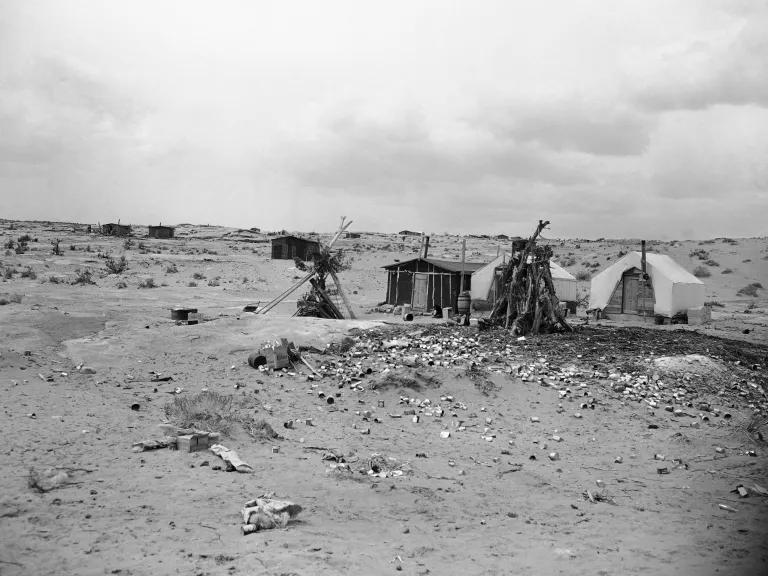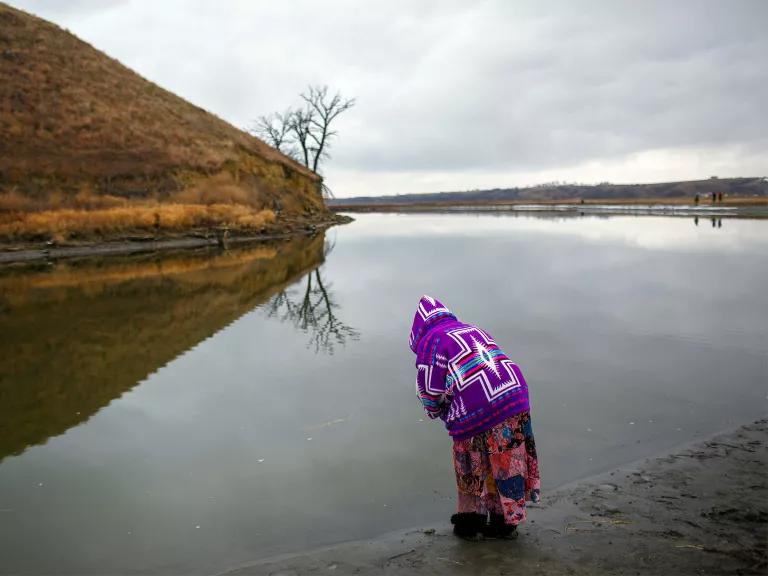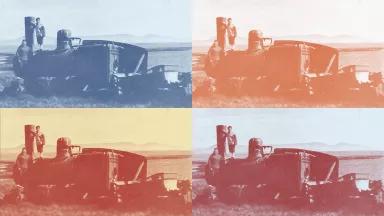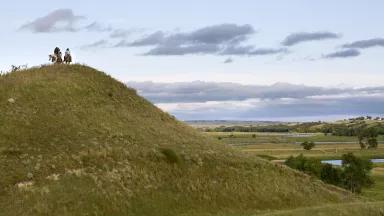When You Poison Our Lands, You Poison Us
The granddaughter of a Navajo uranium miner stands with the Standing Rock Sioux against DAPL.

Hannah as a young child
Courtesy of Hannah Throssel
A dry wind whistles through the windows of my grandfather’s house on a gusty day in Steamboat, Arizona, which sits at the center of Dinétah, the Navajo Nation. This was my first home and remains my sanctuary. I moved away as an infant, but as a young girl, I spent my summers here with my grandparents, helping to tend the family sheep camp, playing “rez ball,” and reading anything I could get my hands on for entertainment. It was a life devoid of basic utilities (my grandparents didn’t have electricity or running water until 2012), but one filled with love and culture. I embraced it all.
Inside the house, my grandpa paces, his cane creating rhythmic creaks against the ripping linoleum. I listen intently as he tells me of his nurse who visits weekly to take his vitals and administer his treatments. He has lived with prostate cancer for the past nine years. Although the exact cause of his cancer—along with my late grandmother's vitiligo, an autoimmune skin condition—is undetermined, our family strongly suspects a connection to their time spent living in Kayenta. The small community—about a two-hour drive to the north—is where my grandpa worked as a uranium miner.

Tents and cabins of Indigenous uranium miners dot the hillside of the Navajo reservation in Arizona, on May 24, 1952. The miners eat much of their food out of cans, being a long way from fresh food centers.
Edward O. Eisenhand/AP Photo
After meeting at Chemawa Indian School in Salem, Oregon, my grandparents returned to Dinétah. It was the 1950s, and there weren’t many jobs on the Navajo Nation (a reality that continues today). So my grandfather jumped at an opportunity to work close to home and be near my grandma and their children. He sought employment in the North Central Uranium Mine Region, which spans about 2,829 square miles within the Navajo Nation.
Between the end of World War II and the mid-1980s, mining companies, contracted by the U.S. government, extracted 30 million tons of uranium ore from within or around Navajo lands. The Navajo Nation Council banned uranium mining in 2005, but the industry’s legacy continues to haunt us. The mining companies abandoned at least 523 mines—all remain contaminated, with many releasing uranium into aquifers, streams, and the air as well as into our homes and bodies. In just two decades, from the 1970s to the 1990s, cancer rates doubled among Diné, the Navajo people. Higher rates of lung, kidney, cardiovascular, and thyroid cancers, and autoimmune diseases have been linked to uranium exposure. Our ancestral homelands, once a source of strength and nourishment, became hazardous to our well-being.
From Dinétah to DAPL
Far from my grandparents’ sheep camp, I spent this past summer in New York City. While working toward a master’s degree in social work from Columbia University, I interned with NRDC and researched the myriad threats that the Dakota Access Pipeline (DAPL) poses to the Standing Rock Sioux Tribe. The experience is one I never would have conceived as a “rez kid,” but in engaging with Standing Rock leaders, I learned firsthand what they’ve gone through in the fight to protect their lands, health, and way of life, and it was all too familiar.
Having witnessed what extractive industries inflicted upon my own family and Dinétah (actions sanctioned by the U.S. government), I stand against the continued transportation of crude oil beneath Lake Oahe, a crucial resource of water, food, culture—of life—for the Standing Rock Sioux.
Last month, the U.S. Army Corps of Engineers (the Corps) released a draft Environmental Impact Statement (DEIS) that fell short of shutting DAPL down. The list of the Corps’s failures on this matter is long, but I can’t help but be struck by the DEIS’s unsound emergency response and health-care planning in the case of a DAPL disaster. The fallout from crude oil polluting Lake Oahe would jeopardize the health and well-being of the Standing Rock community for generations to come. And the reality is that IHS would be woefully unprepared to care for those harmed by it.

Water protectors cross the Missouri River during a direct action against the Dakota Access Pipeline, in November 2016.
Hossein Fatemi/Panos Pictures/Redux
I grew up receiving all of my health care through IHS and later worked in an urban IHS clinic. There, I witnessed the challenges of sustaining adequate numbers of medical professionals while securing sufficient funding for the basic health-care needs of Indigenous communities. This lack of resources and economic support was evident during the COVID-19 pandemic, which wreaked havoc among Indigenous Peoples. At the peak of my grandfather’s cancer treatments, he had to commute two-and-a-half hours to Flagstaff, the nearest major city. While my family is fortunate to own a reliable vehicle, one that can withstand long drives and the elements of the desert, this is certainly not the case for many families on the Navajo Nation.
We don’t take good health care for granted, and we certainly can’t rely on the U.S. government to protect us. Despite knowing that uranium miners faced high risks for lung cancer (based on observations made earlier in the century in Europe), the federal government didn’t provide any protections, such as basic ventilation, to miners until 1962, after reportedly suppressing information about its dangers in the 1950s. Now, more than 70 years later, efforts by the U.S. Environmental Protection Agency to assess and clean up just 230 of the contaminated uranium mines have only recently begun.
When the uranium mines closed, my grandfather began a long career with the Union Pacific Railroad in Southern California. Afterward, he again returned to Dinétah. Our ancestral home, my grandmother once told me, equips us with strength and resilience to navigate life’s challenges, and her wisdom has guided me through many of my own.
The wind whooshes across the landscape, and I think of it as the persistent, gentle whispers of our people’s stories and struggles. Whether in Arizona, South Dakota, or elsewhere, the connection that Indigenous peoples have with the land extends beyond mere ownership, beyond colonial borders—it is intricately woven into the fabric of our identity. Protecting its waters, wildlife, and soils from contamination preserves this bond to the land and, in turn, preserves ourselves.
This NRDC.org story is available for online republication by news media outlets or nonprofits under these conditions: The writer(s) must be credited with a byline; you must note prominently that the story was originally published by NRDC.org and link to the original; the story cannot be edited (beyond simple things such as grammar); you can’t resell the story in any form or grant republishing rights to other outlets; you can’t republish our material wholesale or automatically—you need to select stories individually; you can’t republish the photos or graphics on our site without specific permission; you should drop us a note to let us know when you’ve used one of our stories.



Water Is Life—from Standing Rock to Oaxaca’s Mixtecan Highlands
The Unlikely Takedown of Keystone XL
The Future Has Spoken: It’s Time to Shut Down DAPL and Stop Line 3